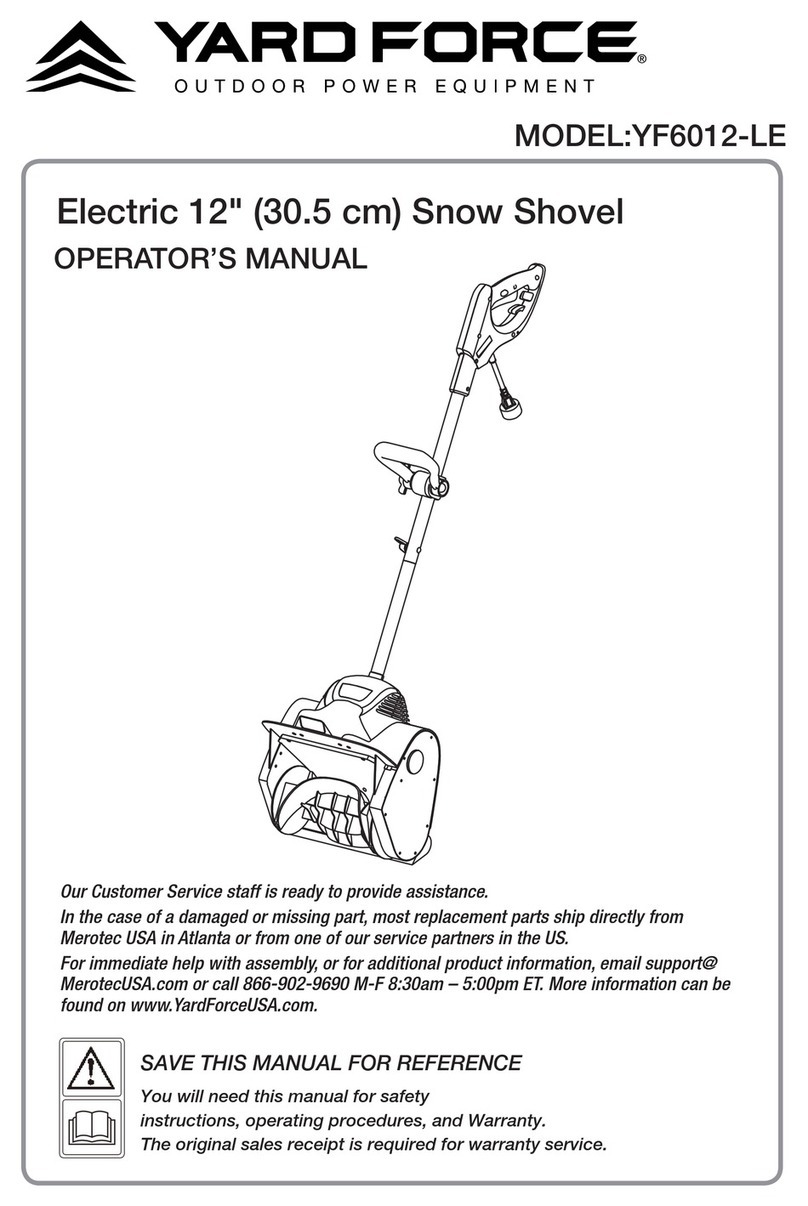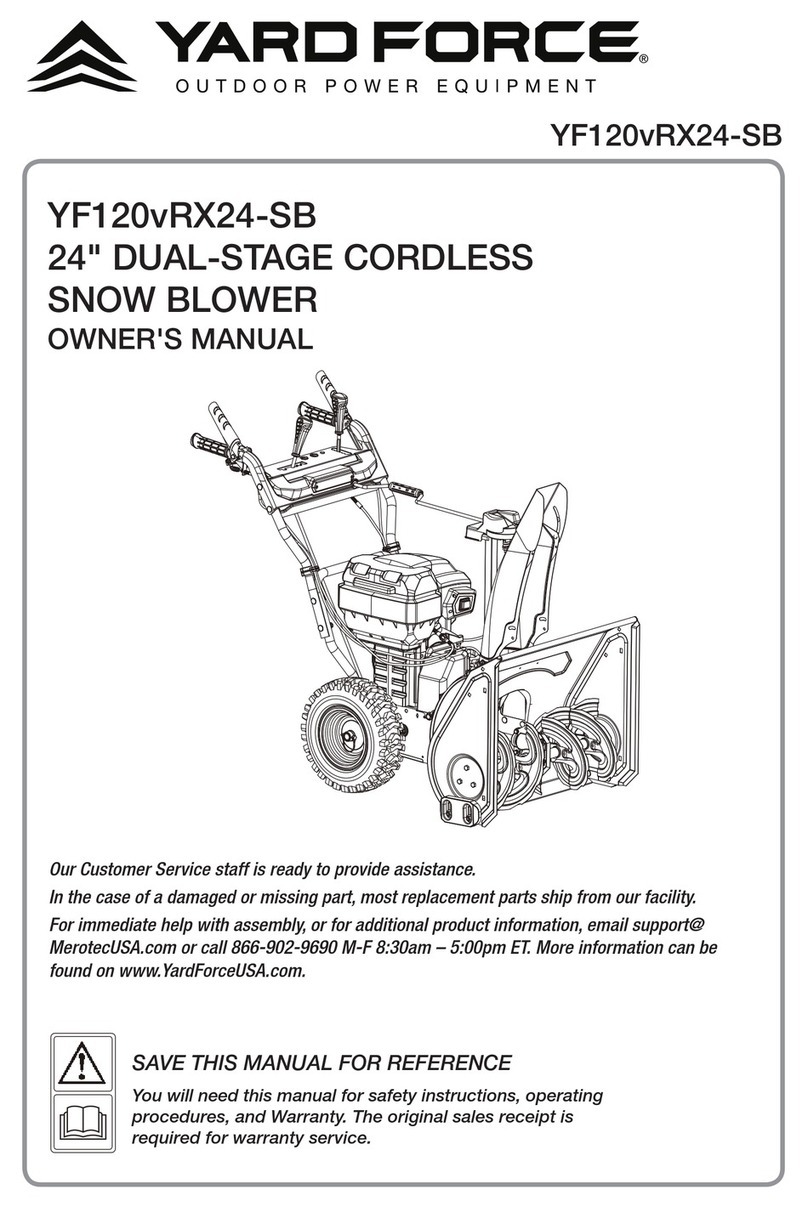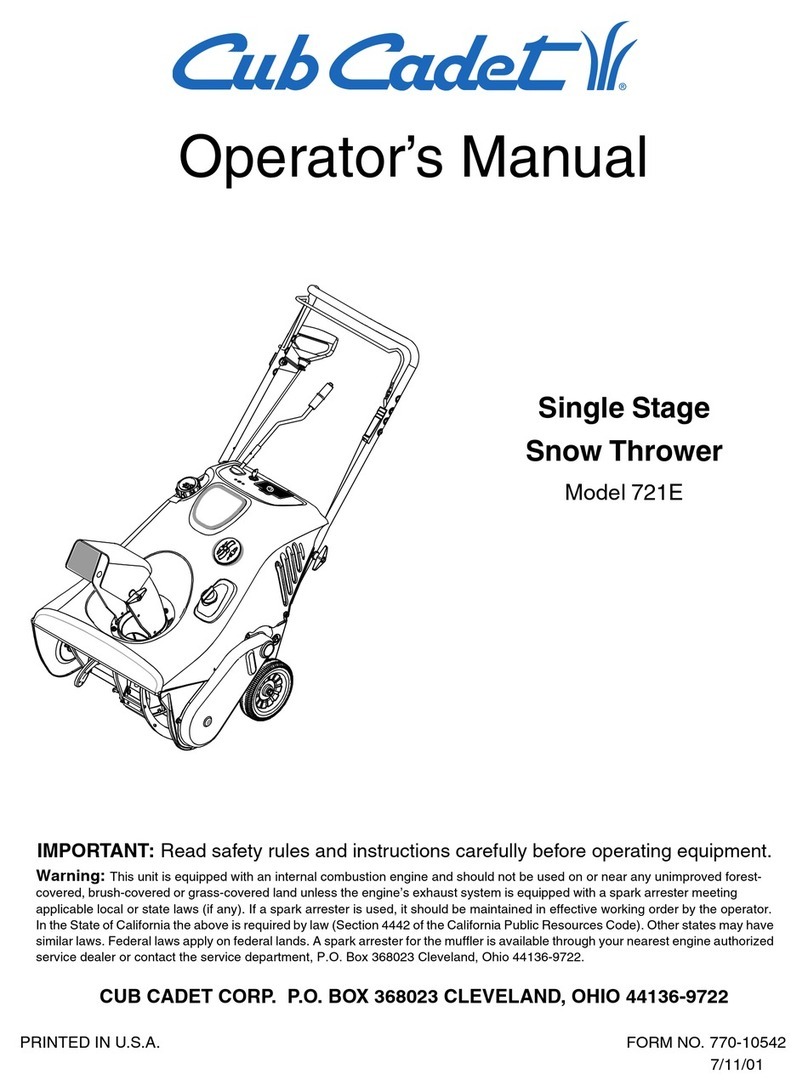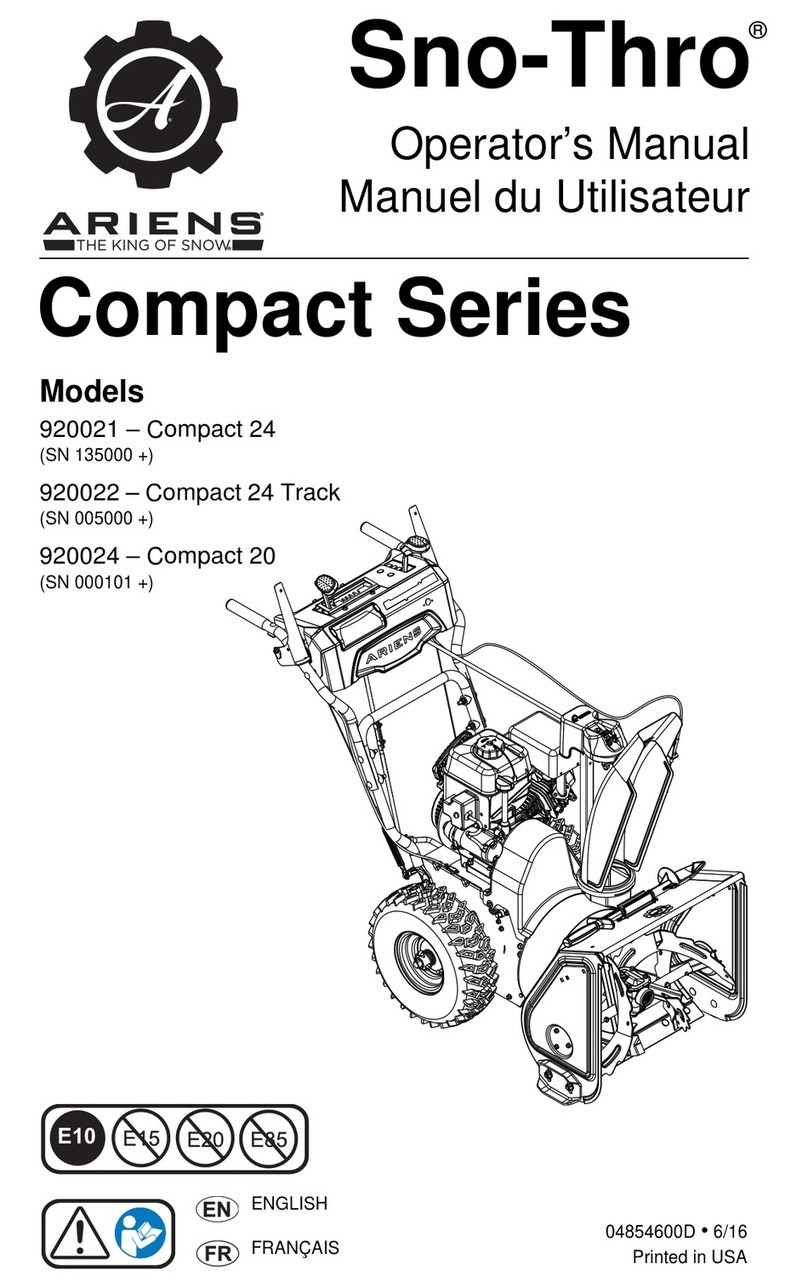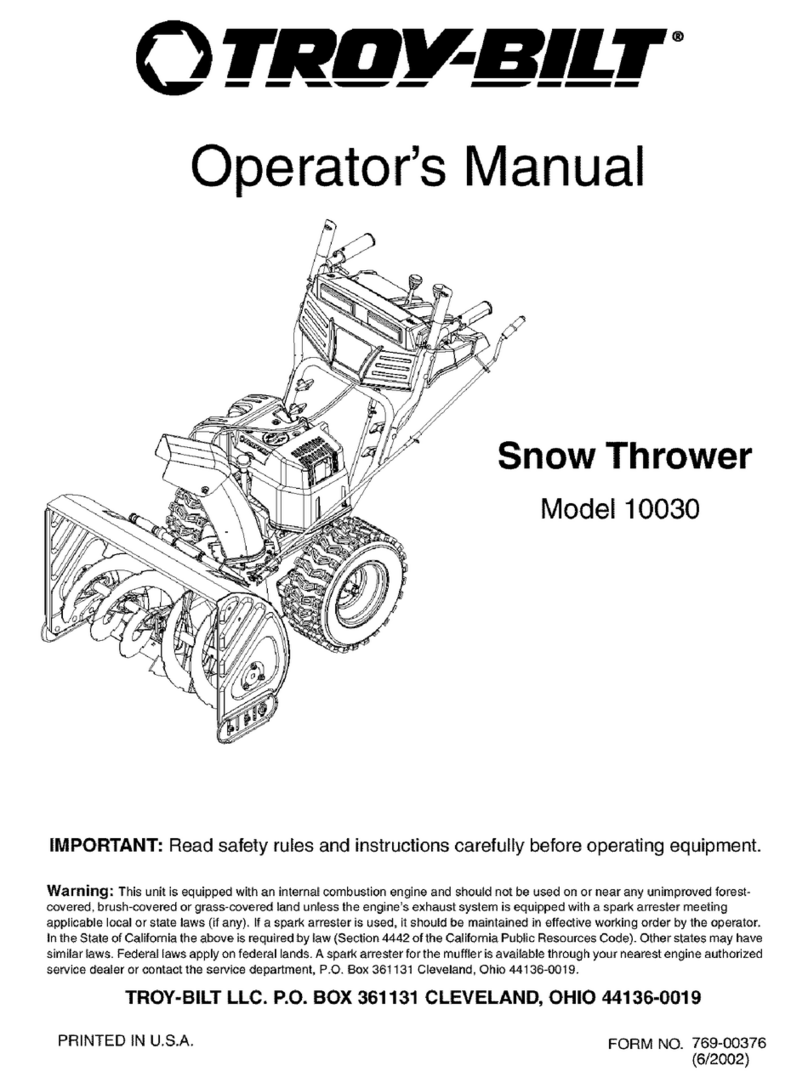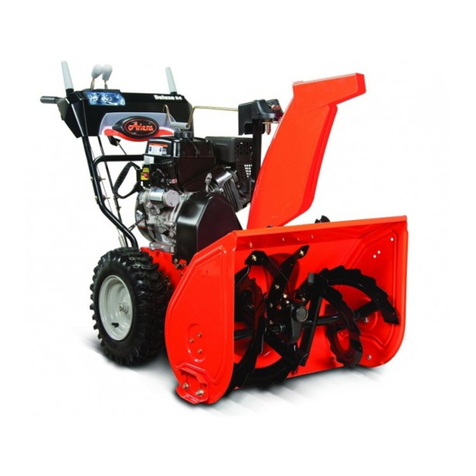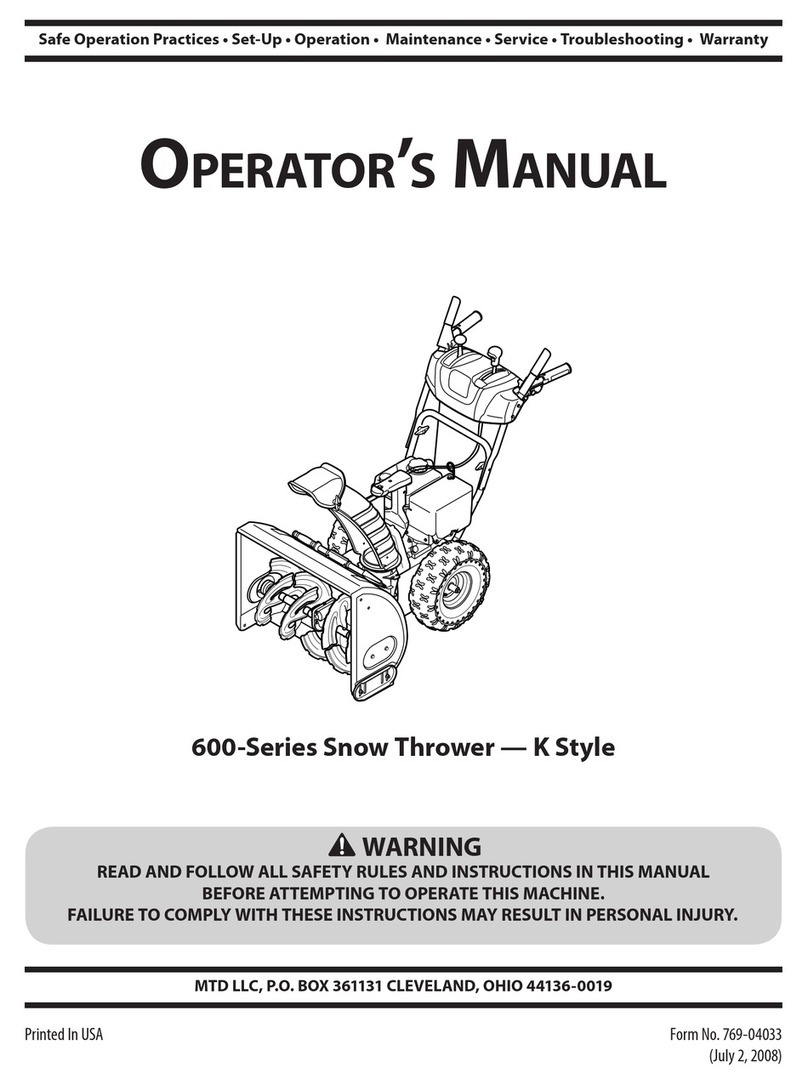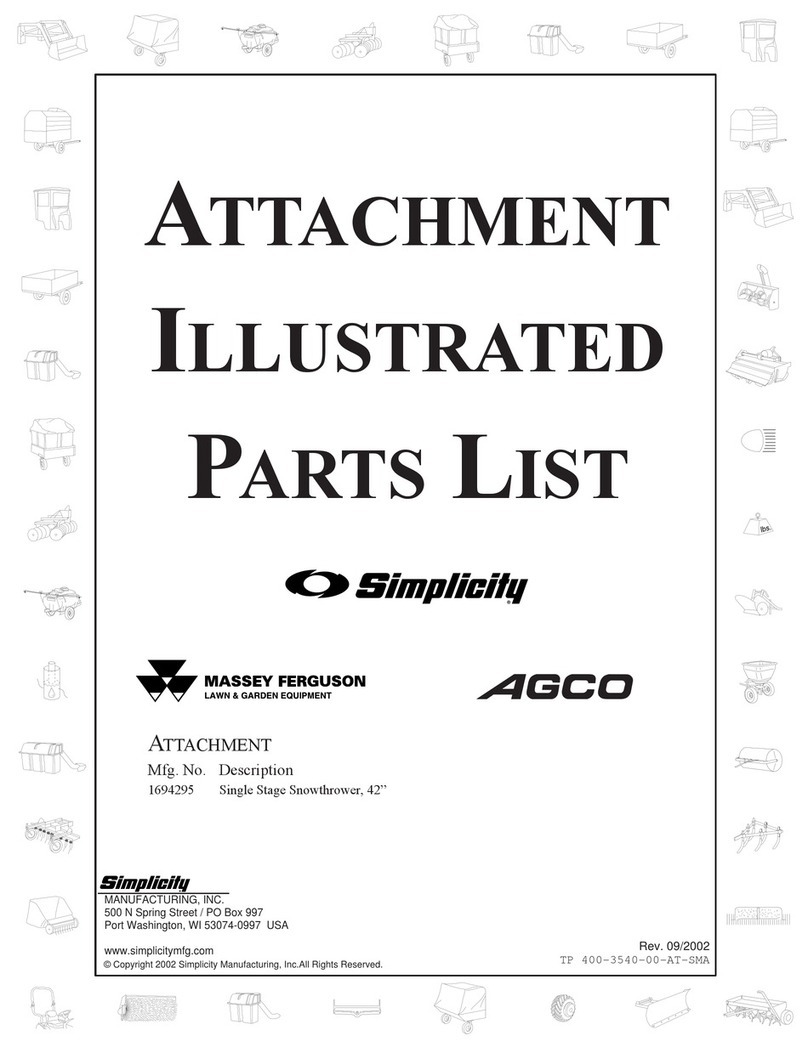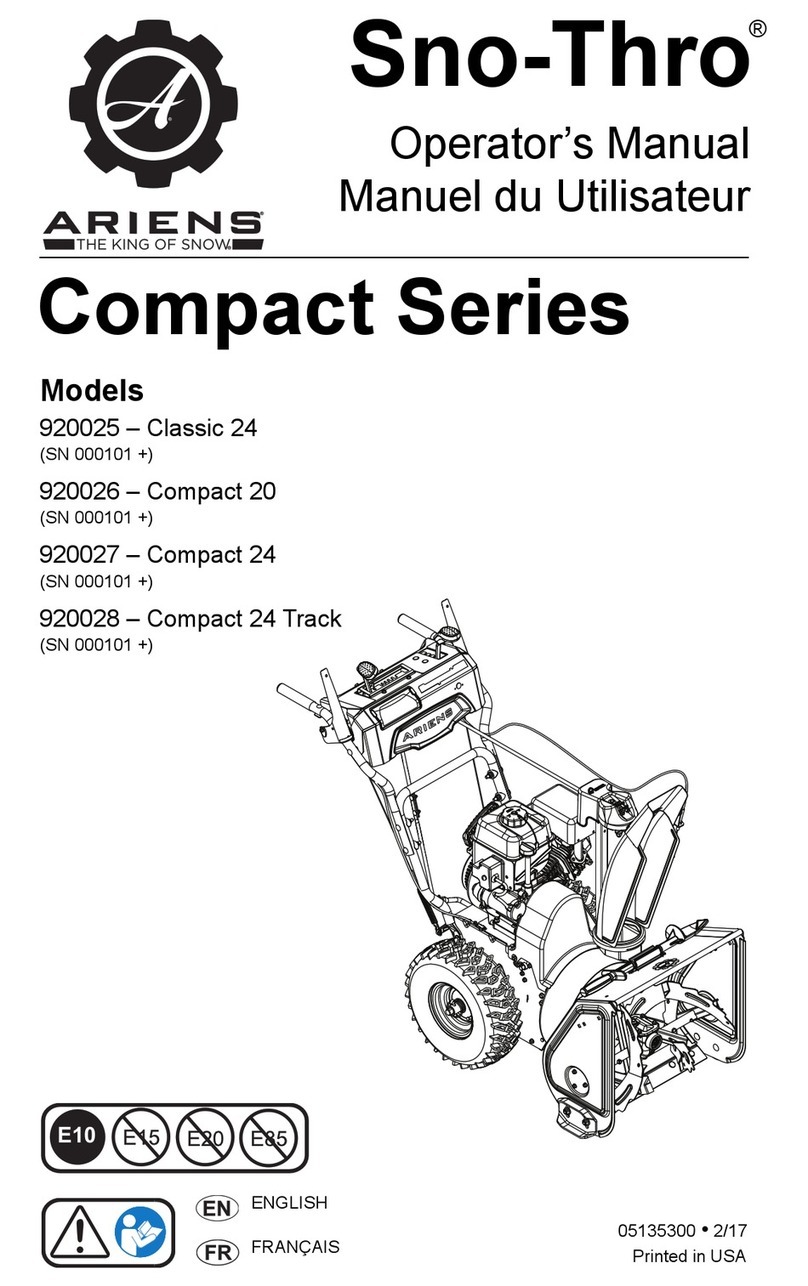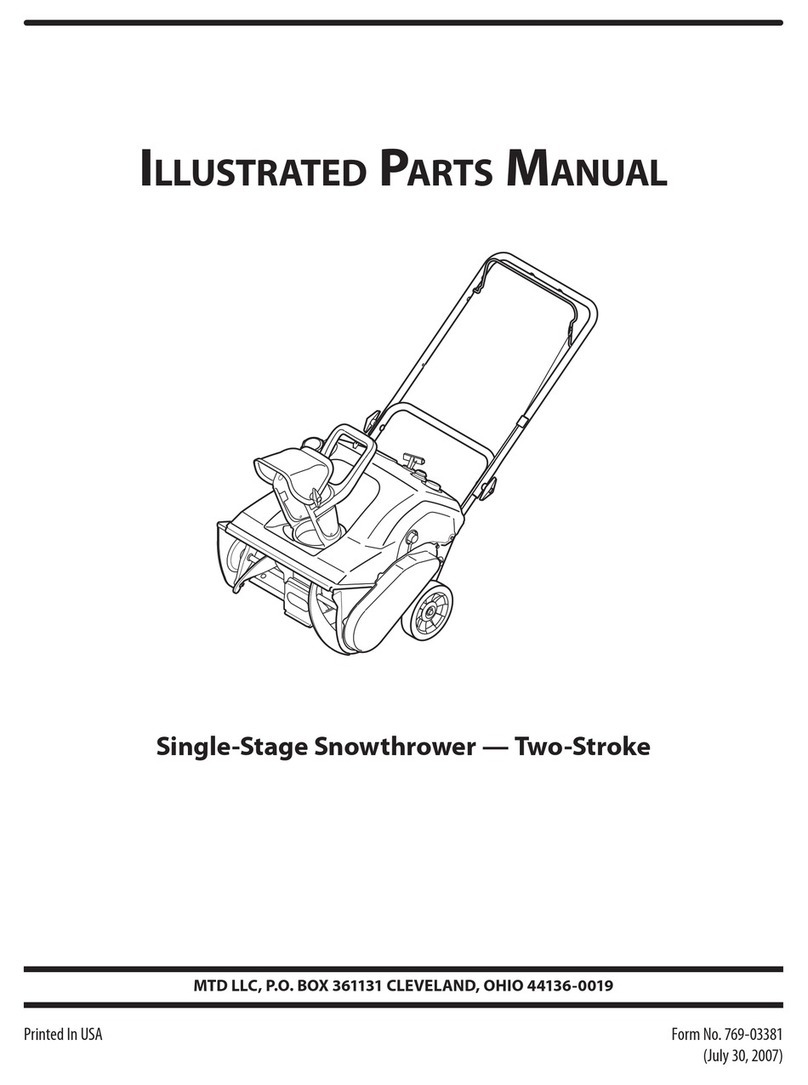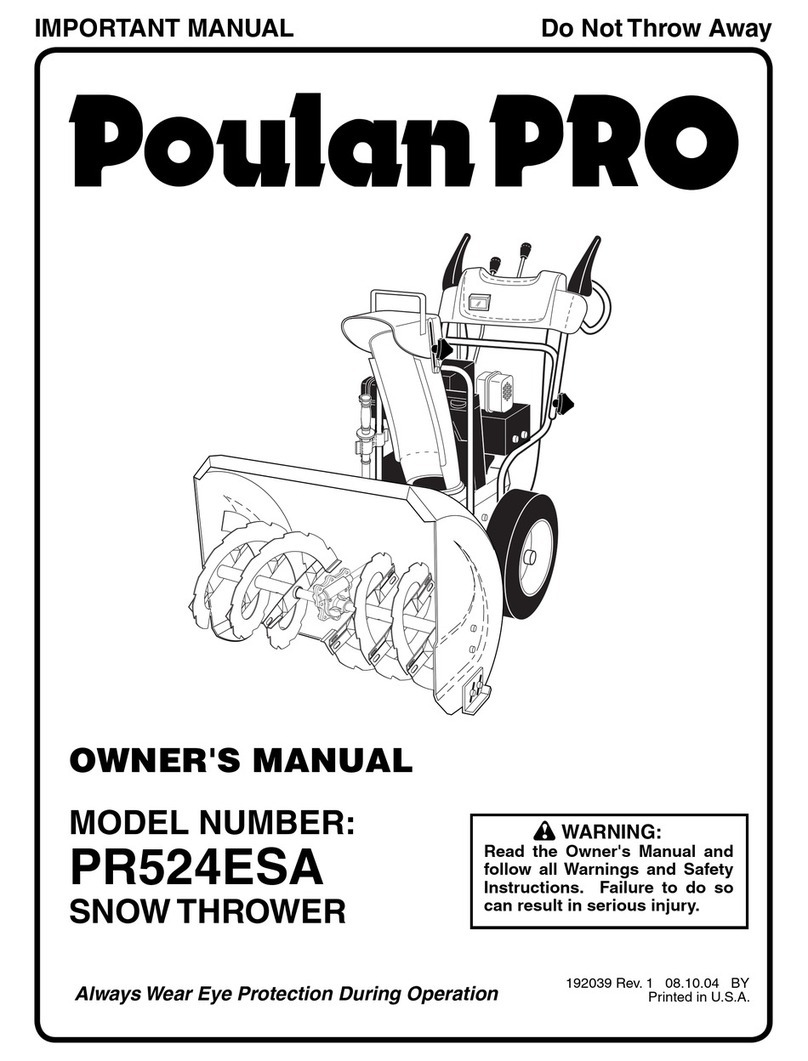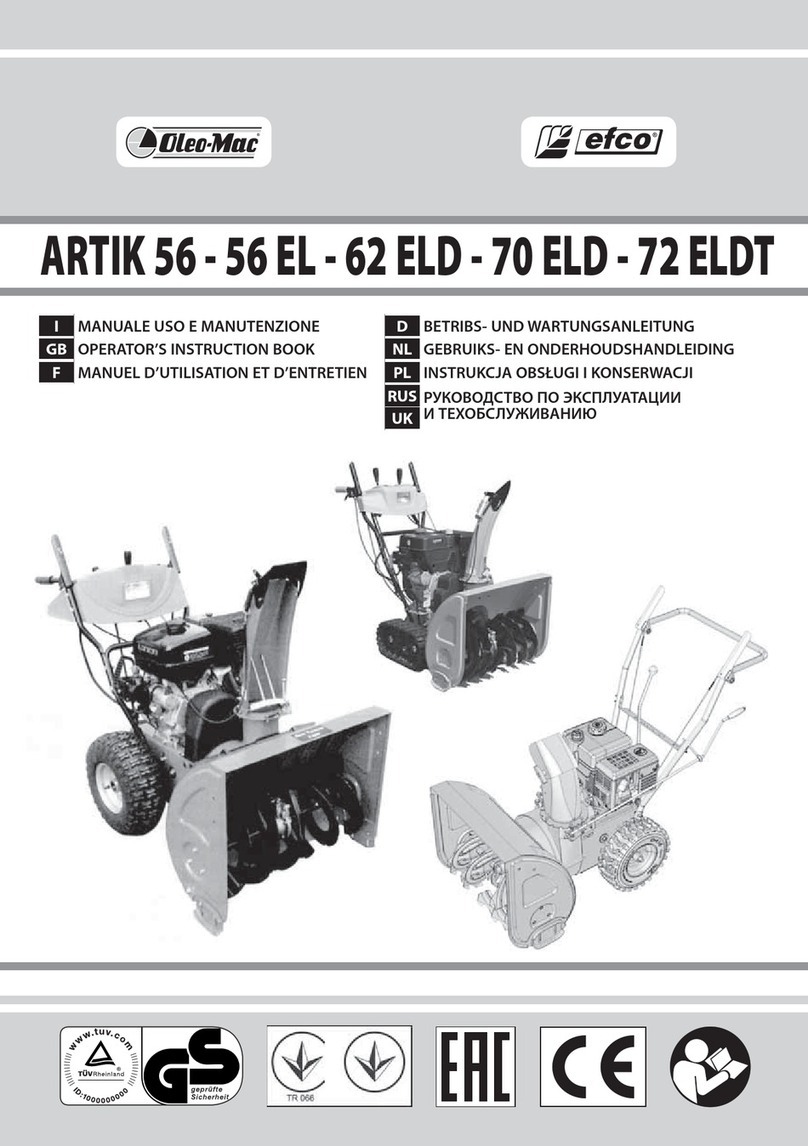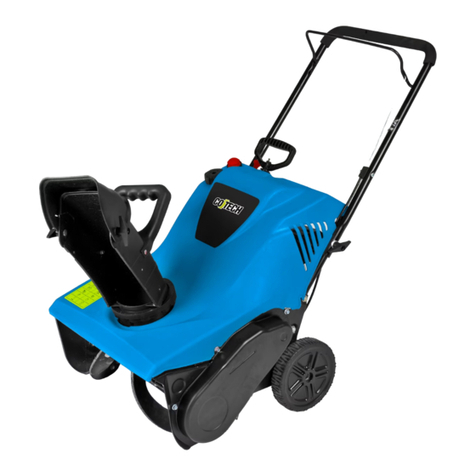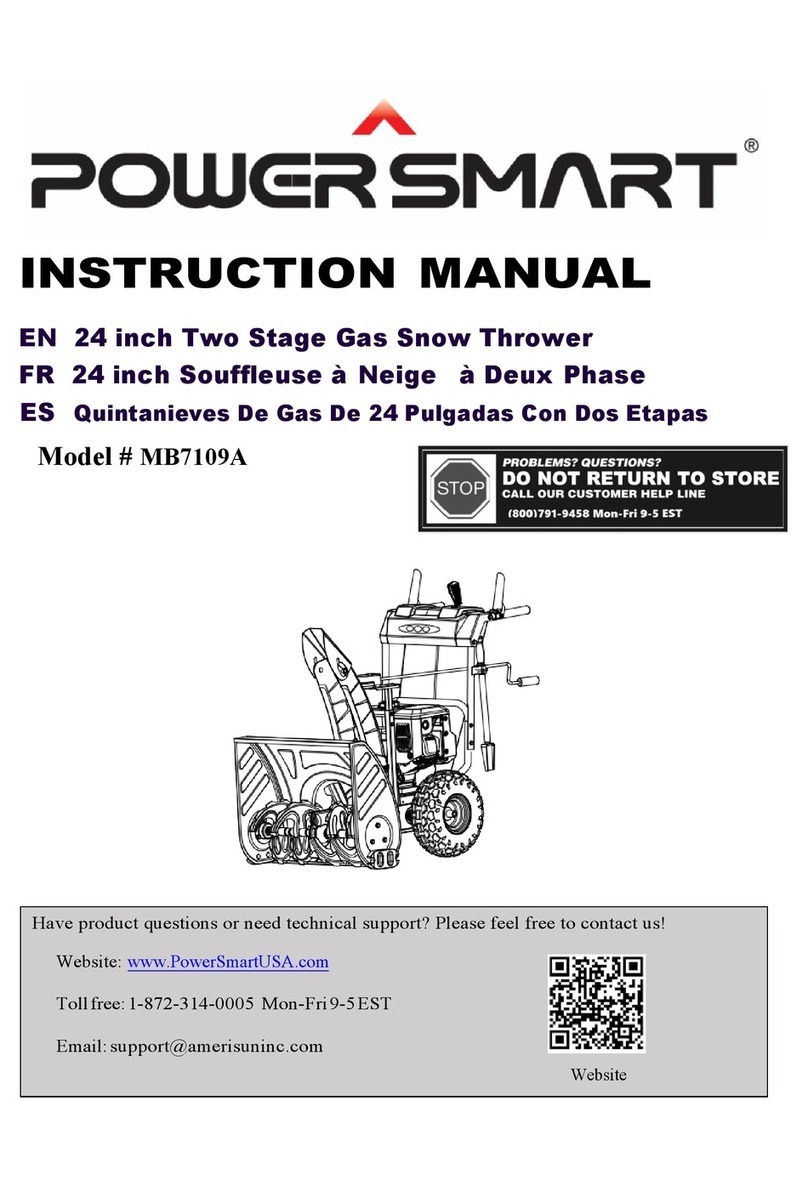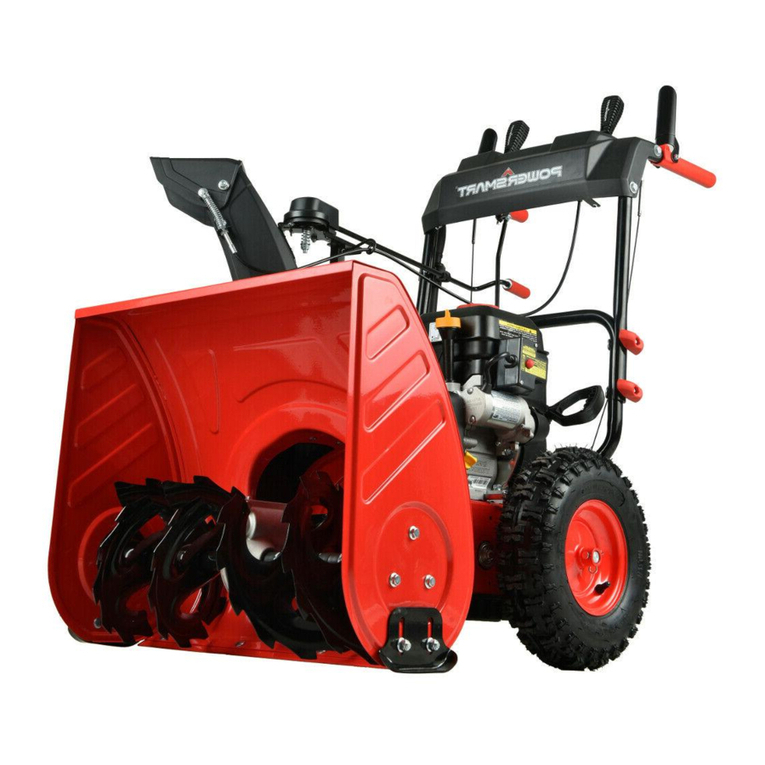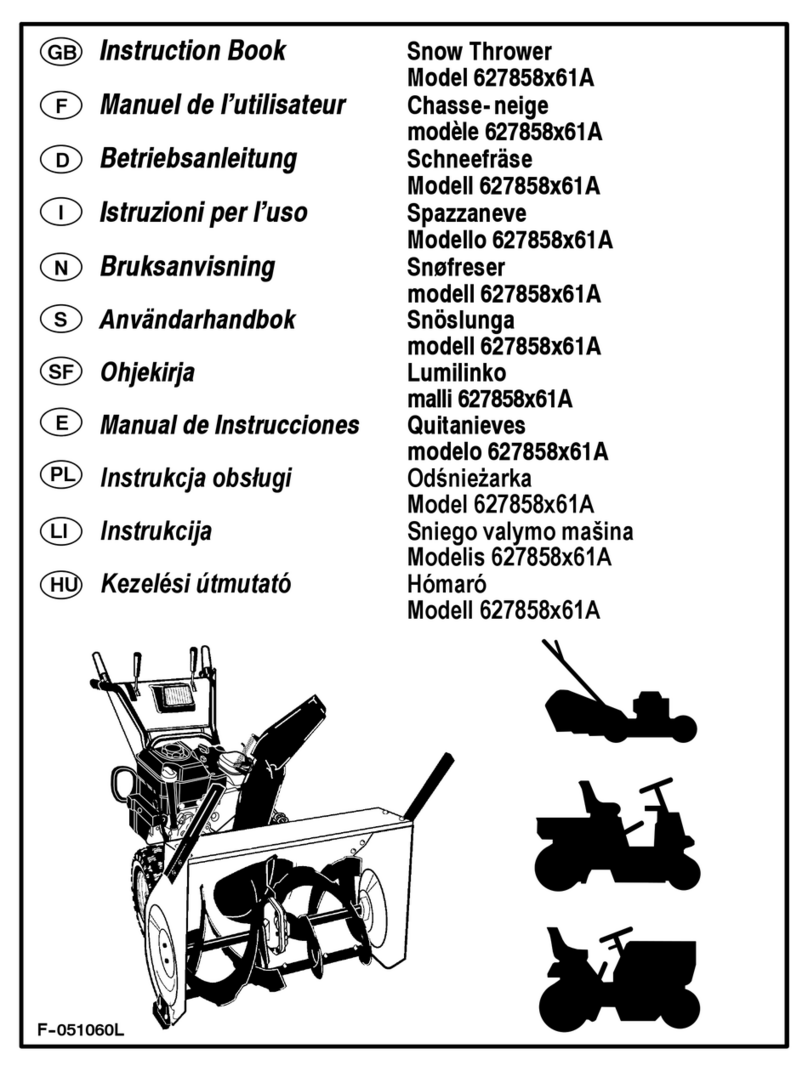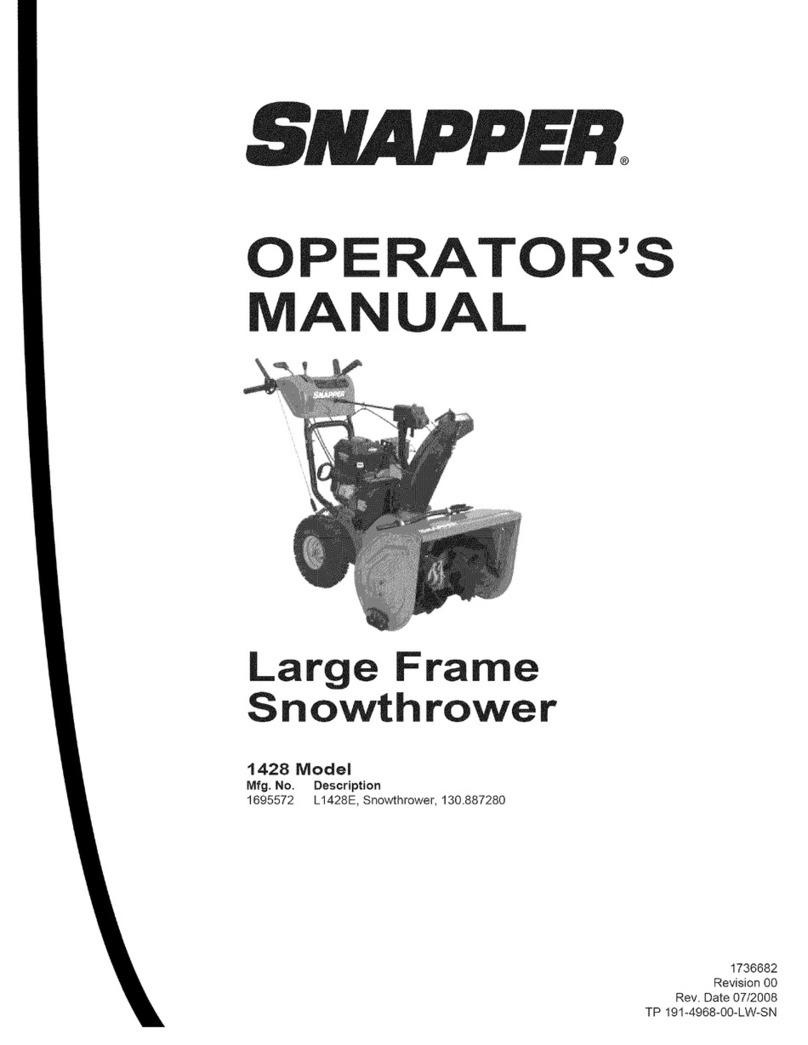Yard force YF60VRX22-ST User manual

OPERATOR’S MANUAL
22” CORDLESS SNOW BLOWER
Our Customer Service staff is ready to provide assistance.
In the case of a damaged or missing part, most replacement parts ship directly from
Merotec USA in Atlanta or from one of our service partners in the US.
For immediate help with assembly, or for additional product information, email support@
MerotecUSA.com or call 866-902-9690 M-F 8:30am – 5:00pm ET. More information can be
found on www.YardForceUSA.com.
SAVE THIS MANUAL FOR REFERENCE
You will need this manual for safety
instructions, operating procedures, and Warranty.
The original sales receipt is required for warranty service.
YF60VRX22-ST

2
NOTICE
This YF60vRX Hand-held Tool has a
2-Step Battery Latch
INSTALLATION: The battery latch has 2 positions.
Press down firmly until battery is fully inserted. If the battery
is not fully inserted and secured in the deepest position #2
the tool will not run.
REMOVAL: Press the
release button once, the
battery will release from the
first latch position. Then hold
the battery firmly, press the
release button again and pull
battery out.
Contactour Customer Care Center
in Georgia for help with:
Product Assembly or Use
Missing Parts
Troubleshooting
866-902-9690 M-F 8:30am – 5:00pm ET
You can also visit the Yard Force USA
website to download owner’s manuals,
get product information and request
tech support.
www.YardForceUSA.com
Latch #1
Latch #2

3
4
4
10
11
12
16
19
20
TABLE OF CONTENTS
WARNING
1. For safe operation,read and understand the instruction manual.
2. To reduce the risk of electric shock, do not expose your cordless tool to water or rain.
3. Replace damaged parts immediately.
4.
5.
Disconnect and remove the battery pack before servicing.
7.
Do not use when children or others are around. Keep safety devices(guards, shields,
switches etc.) in place and working.
8.
9.
Remove objects that could be thrown by or become entangled in the snowblower.
Use only 60V Li-ion battery YF60VRX4.0-BAT & YF60VRX2.5-BAT and battery charger.
Never direct the snow discharge chute at the operator,at bystanders,at vehicles,or at windows.
6.
Some dust created by power sanding, sawing, grinding, drilling and other construction
activities contains chemicals known to the state of California to cause cancer, birth defects
or other reproductive harm. Some examples of these chemicals are:
• Lead from lead - based paints
• Crystalline silica from bricks and cement and other masonry products, and
• Arsenic and chromium from chemically -treated lumber.
Your risk from these exposures varies,depending on how often you do this type of work.
To reduce your exposure to these chemical: work in a well ventilated area,and work with
approved safety equipment,such as those dust masks that are specially designed to filter
out microscopic particles. For more information go to www.P65warnings.ca.gov.

4
PRODUCT SPECIFICATIONS
Motor Brushless
Battery Voltage Max* 60 V D.C.
Battery Capacity 4.0 Ah
Battery Runtime Max Working time up to 30
mins.
No-load running time
up to 45 mins.
Charger Input 100-240 V, 50/60 Hz
Charger Output 63 V D.C. 4 A
Charge Time Max 1 hour
No Load Speed 2500 RPM
Impeller Size 8 in. (20 cm)
Clearing Width 22 in. (56 cm)
Clearing Depth 10 in. (25 cm)
Discharge Distance Max 30 ft (9 m)
Plowing Capacity Max 25 Tons Per Hour
Stages Single Stage
Type of Snow Medium Usage
Directional Control 180oAdjustable Chute
LED Light 3 W
Tire size 7 in. (18 cm)
Net Weight 41 lb (18.6 kg)
GENERAL SAFETY INSTRUCTIONS
Notice the personal safety alert symbol used in
this manual to draw your attention to a WARNING
given along with the particular operating
instruction. This means that the operation
requires special ATTENTION, CAUTION, and
AWARENESS.
• Keep work area clean and well lit – Cluttered,
dark areas invite accidents.
• Keep bystanders away – All bystanders and
pets should be kept a safe distance away
from the work area.
• Dress properly – Do not wear loose clothing
or jewelry. They can get caught in moving
parts. Protective rubber gloves and non-slip
footwear are recommended when working
outdoors.
• Use the right product – Do not use this
machine for any job except that for which it is
intended.
• CAUTION! – Exercise caution to avoid
slipping or falling. Wear protective footwear
that will protect your feet and improve your
footing on slippery surfaces.
• Use safety glasses – Also use safety
gloves, hearing and head protection.
• Do not force the snow blower – Use the snow
blower at the rate for which it was designed
to ensure optimal performance and safe
operation.
• Stay alert – Watch what you are doing. Use
common sense. Do not operate the snow
blower when you are tired or under the
• Do not overreach – Keep proper footing and
balance at all times.
• Store indoors – When not in use, the snow
blower should be kept dry and stored out of
the reach of children in a high or locked place.
• Maintain snow blower with care – Follow
instructions for lubricating and changing
accessories.
WARNING: Always disengage the switch
lever and remove the battery pack before
making any adjustments, inspecting,
servicing, changing accessories, cleaning
the snow blower, or when any other
dangerous conditions are present. Any
such operation should be performed after
revolving parts inside the snow blower
stop completely. Such preventive safety
measures reduce the risk of starting the
power tool accidentally.
WARNING: When replacing any parts, you
must strictly observe the instructions and
procedures described in this user manual.
Special care should be paid to any rubber
parts, since these parts may increase the
motor load and decrease its mechanical
power if damaged.
WARNING: If you notice that the snow
blower is not running properly or hear
abnormal sounds from the motor when it
is in use, immediately stop the machine,
disconnect the battery, and contact your
service centre.
• Surfaces – This snow blower is intended for
use on paved surfaces. Do not use on gravel,
stone or other unpaved surfaces. unless the
snow blower is adjusted for such surfaces

5
according to the instructions given in the
operator’s manual.
• Moving parts present risks – Keep your
face, hair, clothing, hands and feet away
from moving parts. All guards and safety
attachments must be installed properly before
using the unit. Shut off and disconnect the
battery before touching any parts other than
the handles and switch.
• Avoid unintentional starting – Make sure the
safety switch and the switch lever are in the
off position before inserting the battery in the
unit. Do not carry the snow blower with the
safety switch and the switch lever engaged.
• Do not overreach – Maintain proper footing
on the ground and tightly grasp the handle
bar. Watch for uneven surfaces and do not
overreach. In case you fall or collide with the
snow blower, inspect the unit for any damages
or cracks. When stepping backwards, be
careful to avoid obstacles beneath your feet
or behind you to avoid falling.
WARNING: If the snow blower strikes any
object, follow these steps: i) Stop the snow
blower. Remove the battery. ii) Inspect for
damage. iii) Repair any damage before
restarting and operating the snow blower.
BATTERY & CHARGER SAFETY
INSTRUCTIONS
We pay a great deal of attention to the design of
every battery pack to ensure that we supply you
with batteries that are safe, durable and have
a high energy density. The battery cells have a
wide range of safety devices. Each individual
cell is initially formatted and its electrical
characteristic curves are recorded. This data is
then used exclusively to be able to assemble the
best possible battery packs.
Despite all the safety precautions, caution
must be exercised when handling batteries.
The following points must be obeyed at all
times to ensure safe use. Safe use can only
be guaranteed if undamaged cells are used.
Incorrect handling of the battery pack can cause
cell damage.
IMPORTANT:
and poor care of highperformance batteries are
the main factors responsible for personal and/or
product damage.
WARNING: Read all safety warnings and
instructions. Failure to follow the warnings
and instructions may result in electric
WARNING: Use only approved replacement
batteries; other batteries may damage the
snow blower and cause it to malfunction.
CAUTION: To reduce the risk of injury,
charge the 60V lithium-ion battery packs
only in their designated 60V lithium-ion
charger. Other types of chargers present
not wire a battery pack to a power supply
plug or car cigarette lighter. Such misuse
will permanently disable or damage the
battery pack.
• Avoid dangerous environments – Do not
charge the battery pack in rain, snow or
in damp or wet locations. Do not use the
battery pack or charger in the presence of
explosive atmospheres (gaseous fumes, dust
be generated when inserting or removing the
• Charge in a well-ventilated area – Do not
block the charger vents. Keep them clear
to allow for proper ventilation. Do not allow
battery pack. Vented gases may explode.
NOTE: The safe temperature range for the
battery is -4oF to 113
o
F (-20
o
C to 45
o
C).Do
not charge the battery outside in freezing
weather; charge it at room temperature.
• Maintain charger cord – When unplugging
the charger, pull the plug, not the cord, from
the receptacle to reduce the risk of damage
to the electrical plug and cord. Never carry
the charger by its cord or yank it by the cord
to disconnect it from the receptacle. Keep the
cord away from heat, oil and sharp edges.
Make sure the cord will not be stepped on,
tripped over or subjected to damage or
stress when the charger is in use. Do not use
the charger with a damaged cord or plug.
Replace a damaged charger immediately.
• Do not use an extension cord unless it is
absolutely necessary – Using the wrong cord,
damages or improperly wired extension
If an extension cord must be used, plug the
charger into a properly wired 16 gauge or

6
larger extension cord with the female plug
matching the male plug on the charger.
Make sure that the extension cord is in good
electrical condition.
• Charger is rated for 120 volt AC only – The
charger must be plugged into an appropriate
receptacle.
• Use only recommended attachments –
Use of an attachment not recommended or
sold by the battery charger or battery pack
shock or personal injury.
• Unplug charger when not in use – Make sure
to remove battery packs from unplugged
chargers.
WARNING: To reduce the risk of electric
shock, always unplug the charger before
performing any cleaning or maintenance.
use a Ground Fault Circuit Interrupter
(GFCI) to reduce shock hazards.
• Do not burn or incinerate battery packs –
Battery packs may explode, causing personal
injury or damage. Toxic fumes and materials
are created when battery packs are burned.
• Do not crush, drop or damage battery packs –
Do not use the battery pack or charger if they
have sustained a sharp blow, been dropped,
run over or have been damaged in any way
(i.e. pierced with a nail, hit with a hammer,
stepped on, etc.).
• Disconnect the battery pack from the tool
before making any adjustments, changing
accessories, or storing tool – Such preventive
safety measures reduce the risk of starting
the tool accidentally.
• Avoid unintentional starting – Make sure the
safety switch and the switch lever are in the
off position before inserting the battery in
the unit. Do not carry the snow blower with
the safety switch and the ON/OFF trigger
engaged.
• When battery pack is not in use, keep it away
from other metal objects – like paper clips,
coins, keys, nails, screws or other small metal
objects that can make a connection from
one terminal to another. Shorting the battery
• Under abusive conditions, liquid may be
ejected from the battery; avoid contact – If
If liquid contacts eyes, additionally seek
medical help. Liquid ejected from the battery
may cause irritation or burns.
• Do not use a battery pack or tool that is
batteries may exhibit unpredictable behaviour
•
temperature above 130oC (265oF) may cause
explosion.
• Follow all charging instructions and do not
charge the battery pack or tool outside of
instructions – Charging improperly or at
may damage the battery and increase the risk
•
person using only identical replacement
parts – This will ensure that the safety of the
product is maintained.
• Do not modify or attempt to repair the tool or
the battery pack – (as applicable) except as
indicated in the instructions for use and care.
• Do not disassemble – Incorrect reassembly
may pose a serious risk of electric shock,
If the battery or charger are damaged,
please contact customer service center at
866-902-9690.
• Battery chemicals cause serious burns –
Never let a damaged battery pack contact
the skin, eyes or mouth. If a damaged battery
pack leaks battery chemicals, use rubber or
neoprene gloves to safely dispose of it. If
affected area with soap and water and rinse
with vinegar. If eyes are exposed to battery
minutes and seek medical attention. Remove
and dispose of contaminated clothing.
• Store your battery pack and charger in a cool,
dry place – Do not store the battery pack or
charger where temperatures may exceed
104oF (40oC), such as in direct sunlight or
inside a vehicle or metal building during the
summer.
INFORMATION ABOUT THE BATTERY
1. The battery packs supplied with your cordless
snow blower are only partially charged. The
battery packs have to be charged completely

7
2. For optimum battery performance, avoid low
discharge cycles by charging the battery pack
frequently.
3. Store the battery pack in a cool place, ideally
at 59oF (15oC) and charged fully.
4. Lithium-ion batteries are subject to a natural
aging process. The battery pack must be
replaced at the latest when its capacity
falls to just 80% of its capacity when new.
Weakened cells in an aged battery pack are
no longer capable of meeting the high power
requirements needed for the proper operation
of your snow blower, and therefore pose a
safety risk.
5.
as this poses a risk of explosion.
6. Do not ignite the battery pack or expose it to
7. Do not exhaustively discharge batteries.
Exhaustive discharge will damage the battery
cells. The most common cause of exhaustive
discharge is lengthy storage or non-use of
partially discharged batteries. Stop working
as soon as the performance of the battery
falls noticeably or the electronic protection
system triggers. Place the battery pack in
storage only after it has been fully charged.
8. Protect the battery and the tool from
overloads. Overloads will quickly result in
overheating and cell damage inside the
battery housing even if this overheating is not
apparent externally.
9. Avoid damage and shocks. Immediately
replace batteries that have been dropped
from a height of more than one meter or those
that have been exposed to violent shocks,
even if the housing of the battery pack
appears to be undamaged. The battery cells
inside the battery may have suffered serious
damage. In such instances, please read the
waste disposal information for proper battery
disposal.
10. If the battery pack suffers overloading
and overheating, the integrated protective
cutoff will switch off the equipment for
safety reasons. If this situation happens,
stop the tool and let the battery cool
down for a few minutes before restarting.
IMPORTANT! Do not press the ON/OFF
trigger any more if the protective cut-off has
been activated. This may damage the battery
pack.
11. Use only original battery packs. The use of
result in injuries or an explosion.
INFORMATION ABOUT THE CHARGER AND
THE CHARGING PROCESS
1. Please check the data marked on the
rating plate of the battery charger. Be sure
to connect the battery charger to a power
supply with the voltage marked on the rating
plate. Never connect it to a different mains
voltage.
2. Protect the battery charger and its cord from
damage. Keep the charger and its cord
away from heat, oil and sharp edges. Have
damaged cords repaired without delay by
service center at 866-902-9690.
3. Electrical plugs must match the outlet.
Never modify the plug in any way. Do not
use any adapter plugs with grounded tools.
reduce the risk of electric shock.
4. Keep the battery charger, battery pack(s) and
the cordless tool out of the reach of children.
5. Do not use the supplied battery charger to
charge other cordless tools.
6. During periods of heavy use, the battery pack
will become warm. Allow the battery pack to
cool to room temperature before inserting it
into the charger to recharge.
7. Do not overcharge batteries. Do not exceed
the maximum charging times. These
charging times only apply to discharged
batteries. Frequent insertion of a charged or
partially charged battery pack will result in
overcharging and cell damage. Do not leave
batteries in the charger for days on end.
8. Never use or charge batteries if you suspect
that it has been more than 12 months since
the last time they were charged. There
is a high probability that the battery pack
has already suffered dangerous damage
(exhaustive discharge).
9. Charging batteries at a temperature below
41oF (5oC) will cause chemical damage to the
10. Do not use batteries that have been exposed
to heat during the charging process, as the
battery cells may have suffered dangerous
damage.
11. Do not use batteries that have suffered
curvature or deformation during the charging

8
process or those that exhibit other atypical
symptoms (gassing, hissing, cracking, etc.)
12. Never fully discharge the battery pack
(maximum recommended depth of discharge
is 80%) A complete discharge of the battery
pack will lead to premature aging of the
battery cells.
PROTECTION FROM ENVIRONMENTAL
INFLUENCES
1. Wear suitable work clothes. Wear safety
goggles.
2. Protect your cordless tool and the battery
charger from moisture and rain. Moisture and
rain can cause dangerous cell damage.
3. Do not use the cordless tool or the battery
4. Use the battery charger and cordless tools
only in dry conditions and at an ambient
temperature of 50oF - 104oF (10oC - 40oC).
5. Do not keep the battery charger in places
where the temperature may reach over
105oF (40.5oC). In particular, do not leave the
battery charger in a car that is parked in the
sunshine.
6. Protect batteries from overheating. Overloads,
overcharging and exposure to direct sunlight
will result in overheating and cell damage.
Never charge or work with batteries that have
been overheated – replace them immediately,
if possible.
7. Store the charger and your cordless tool only
in dry locations with an ambient temperature
of 50oF to 104o
F (10oC to 40 o
C).Store your
lithium-ion battery pack in a cool, dry place at
a temperature of 50oF to 68
o
F (10o
C to 20o
C).
Protect the battery pack, charger and cordless
tool from humidity and direct sunlight. Only
place fully charged batteries in storage.
8. Prevent the lithium-ion battery pack from
freezing. Battery packs that were stored
below 32oF (0oC) for more than 60 minutes
must be discarded.
9. When handling batteries, be wary of
electrostatic charge. Electrostatic discharges
can damage the electronic protection system
and the battery cells. Avoid electrostatic
charging and never touch the battery poles.
ADDITIONAL SAFETY
INSTRUCTIONS
SAFETY INSTRUCTIONS FOR WALK-BEHIND
SNOW BLOWERS
• Read the operator’s manual carefully –
Learn your snow blower’s applications and
hazards related to this machine. Do not use
this machine for any purpose other than
the one for which it was designed. Failure
to adhere to these precautions may cause
mechanical defaults, serious damage, or
personal injury.
• Preliminary unit inspection – Thoroughly
inspect the unit before use. Make sure all
the parts are secure and installed correctly. If
you notice any abnormalities, do not use the
machine until it has been properly repaired.
use the snow blower or after replacing parts
to ensure that the unit is functioning properly.
• Preliminary area inspection – Clear the area
to be plowed before each use. Remove all
objects such as rocks, broken glass, nails,
wire, or string, which can be thrown by or
become entangled in the snow blower. Keep
the area of operation clear of all people,
children, and pets.
• Excessive force – The snow blower was
designed to respond at a certain rate for
various snow conditions for optimal safety and
performance. Do not force it; keep the applied
pressure constant throughout its operation.
• Malfunctioning switch – Do not use the snow
blower if the switch does not turn it on and
off. Any tool that cannot be controlled by
the switch is not safe to use and must be
repaired.
• Hitting an object – If the snow blower
snow blower and remove the battery; next,
any damaged part before restarting and
operating the snow blower.
• Discharge chute safety – Never direct the
snow discharge chute at the operator, at
bystanders, at vehicles, or at windows. The
discharged snow, which may contain foreign
objects accidentally picked up by the snow
blower, can cause serious damage and
personal injury. Do not use your hands to
unclog the discharge chute. Stop the motor
before removing debris.

9
the snow blower in the hand-held position is
unsafe.
•
snow blower is not running properly or hear
abnormal sounds or feel abnormal vibrations
from the motor, immediately stop the
machine, remove the battery, and contact the
customer service center at 866-902-9690 for
assistance.
• Noise control – When using the snow blower,
respect the local laws and regulations
regarding noise control and environmental
protection. To avoid noise disturbance, you
should carefully decide upon an appropriate
operation time and consider the surrounding
conditions.
• When work is completed – Remove the
battery pack from the snow blower when
not in use, when changing accessories, and
before performing any maintenance task.
• Store safely – Store the snow blower indoors
in a dry area between uses. Keep in a locked
area, where children and unauthorized users
cannot gain access. Never store the snow
blower with the battery pack installed. It may
cause damage and injury.
• Maintain for safety and longevity – Check
for misalignment or binding of moving parts,
breakage of parts, and any other conditions
that may affect the unit’s operation. If
damaged, repair or replace the damaged
part before use. Use only those replacement
parts made for your model. When replacing
any parts, you must strictly observe the
instructions and procedures described in this
manual. Special care should be paid to any
rubber parts, since these parts may increase
the motor load and decrease its mechanical
power if damaged.
• Rotating parts – Do not put hands or feet
near or under rotating parts. Keep clear of the
discharge opening at all times.
• Hidden hazards – Exercise extreme caution
when operating on or crossing gravel drives,
walks or roads. Stay alert for hidden hazards
• Exercise extreme caution when operating
on slopes. Never operate the machine at
high transport speeds on slippery surfaces.
Look behind and use care when operating in
reverse.
•Never operate the snow thrower without
good visibility or light. Always be sure of your
Walk; never run.
• Do not overload the machine capacity by
attempting to clear snow at too fast a rate.
• Never allow children to operate the
equipment. Never allow adults to operate the
equipment without proper instruction.
• Adjust the collector housing height to clear
gravel or crushed rock surface.
• Always wear safety glasses or eye shields
during operation or while performing an
adjustment or repair to protect eyes from
foreign objects that may be thrown from the
machine.
CLEARING A CLOGGED DISCHARGE CHUTE
Hand contact with the rotating impeller inside the
discharge chute is the most common cause of
injury associated with snow throwers. Never use
your hand to clean out the discharge chute.
TO CLEAR THE CHUTE: i) SHUT THE MOTOR
OFF! ii) Wait 10 seconds to be sure the impeller
blades have stopped rotating. iii) Always use a
clean-out tool, not your hands.
ELECTRICAL SAFETY
Avoid accidental starting – Make sure the safety
switch and the ON/OFF trigger
is in the OFF position before inserting the battery
pack into the unit. Do not carry
the snow blower with the safety switch and ON/
OFF trigger engaged.
• Hand-held operating position – Operation of

10
SAFETY SYMBOLS
The following table depicts and describes safety
symbols that may appear on this product. Read,
understand and follow all instructions on the
machine before attempting to assemble and
operate.
SAFETY ALERT – Indicates
a precaution, a warning or a
danger.
READ THE OPERATOR’S
MANUAL(S) – Read, understand
and follow all instructions in the
user manual(s) before attempting
to assemble and operate.
Wear hearing protection.
Wear eye protection.
Wear breathing protection.
Keep hands, feet and clothing
away from the rotating auger to
avoid injury.
Wear protective gloves and non-
slip footwear when using the
machine and handling debris.
Do not use hands to unclog
chute.
WARNING! Always turn the
machine OFF and remove the
safety key before conducting
inspection, cleaning and
maintenance.
WARNING! Do not expose the
unit to rain or wet conditions.
Keep dry.
DANGER! Cutting/
dismemberment hazard - Keep
feet awayfrom the rotating auger.
CAUTION! Beware of stones and
other foreign objects that could
be thrown from the tool.
The rotating part will continuously
run for several seconds after you
turn off the machine.
Keep bystanders and children a
safe distance (at least 33 ft/10 m)
away from the work area.
DANGER! Cutting/
dismemberment hazard – Keep
hands away from the rotating
auger. Do not use hands to
unclog rotor housing. Stop motor
before removing debris.
T5A
Protective 5A limited

11
KNOW YOUR CORDLESS SNOW BLOWER
Read the owner’s manual and safety rules carefully before operating your cordless snow blower.
Compare the illustration below the actual unit in order to familiarize yourself with the location of the
various controls and adjustments. Save this manual for future reference.
FUNCTIONS
1. Handle Bar
2. Control Bar
3. Safety Switch Button
4. Joint Fixing Bolt & Knob (4 Pieces)
5. Carrying / Lifting Handle (For Transport Only)
6. Battery Housing Cover
7. Lower Frame
8. Wheel
9. Shave Plate
10. Paddle
11. Main Cover
12. Led Light
13. Lower Chute Crank
14. Discharge Chute
15. Chute Clean-Out Tool
16. Upper Chute Crank
17. Middle Frame
18. Battery
19. Battery Release Button
16 17 19
9 10 11
1
2
3
4
5
6
7
8
15
14
13
12
18

12
GETTING STARTED
1. Remove the snowblower and all other items
from the box.
2. Determine the left and right hand side of
the snowblower by standing in the normal
operating position.
3. Check all items for shipping damage. If
damage is found or suspected or if any of
the parts are missing, do not assemble.
Instead, promptly inform the dealer where
you bought the snowblower or contact at
866-902-9690 for assistance.
4. Check to make sure the upper chute crank is
included.
ASSEMBLING THE HANDLE
1. Secure the connection of the middle frame
to the lower frame by and knobs on each
and knobs on each side (Fig. 1).
2. Secure the connection of the upper frame to
the middle frame by fastening the second set
knobs and bolts on each side (Fig. 2).
4. Clip the 2 chute clean-out tool clips on the
side of the middle frame, and insert the chute
clean-out tool in the clips (Fig. 4-5).
5. Clip on the 2 cable clips on the frame, and
insert the cable inside of the cable clips (Fig.
6).
Cable clips
Cable
Chute
Clean-Out
Tool
Chute
Clean-Out
Tool Clips
Fig. 4
Fig. 6
Fig. 5
DISCHARGE CHUTE ASSEMBLY
1.
(Fig.7).
2. Lift the chute deflector and lock it securely
onto the discharge chute (Fig.8).
Fig. 7
Fig. 8
3.
desired height of the snow stream and tighten
the knob (Fig.9).
NOTE! Do not overtighten the knob.
3. To complete the handle assembly, simply
pull the middle frame back and pull the
upper frame up for easy storage (Fig. 3).
Middle Frame
Knob + Bolt
Knob + T-bolt
Lower Frame
Upper Frame
Middle Frame
Fig. 1
Fig. 2
Fig. 3

13
Fig. 9
CHUTE CRANK ASSEMBLY
1. Remove the cotter pin from the lower chute
crank (Fig.10).
2. Install the lower crank rod by inserting it into
the opening at the back of the housing with
holes aligned (Fig.11).
3. Secure the lower chute crank in place with
the cotter pin (Fig.12).
Cotter Pin
Cotter Pin
Align the
holes
Lower Chute
Crank
Lower Chute
Crank
Fig. 10
Fig. 11
Fig. 12
4. Remove the cotter pin on the crank rod
connector by hand (Fig.13).
5. Slide the upper chute crank through the
rubber ring located on the middle frame
(Fig.14).
6. Slide the upper chute crank into the crank
rod connector (Fig.15).
7. Align the holes and insert the cotter pin by
hand (Fig.16).
Cotter Pin Fig. 16
Upper Chute
Crank
Upper Chute
Crank
Crank Rod
Connector
Rubber Ring
Cotter Pin
Crank Rod
Lower Chute
Crank
Fig. 14
Fig. 15
Fig. 13
NOTE: Before using this machine, make sure
that the power source you will use complies
Before inserting the battery to start, verify that
the snowblower’s roll shaft and rubber plates are
plates are facing the correct direction. Perform a
test run to ensure that the motor turns freely.

14
CHARGING THE BATTERY PACK
NOTE: Remove the battery pack from the
charger after it has been fully charged.
NOTE: Battery should be fully charged before
NOTE: Make sure the mains voltage is the same
as the rating label which is located
on the charger.
1. Connect the charger to a power supply. The
red LED will light up.
2. To insert the battery pack into the charger,
align the raised ribs of the battery pack with
the grooves of the charger then push it in
(Fig.17).
3.
continuously during normal charging.
4. After charging is complete, the charger light
will turn to a solid green light.
Fig. 17
This Li-Ion battery pack is equipped with a power
indicator which is used to show the battery packs
remaining charge. Press the power indicator
button to check battery charge. The LEDs will
stay lit for approximately 4 seconds.
Fig. 18
NOTE:
1. Never allow the battery to completely
discharge before recharging. The battery
pack should be placed on the charger
whenever the battery pack is noticeably
running down or the tool no longer performs
a task as it previously performed.
2. Avoid conducting short charges. Make sure
that the battery is fully charged each time
by allowing the charger to complete its full
charging cycle.
3. Avoid allowing loose items like screws or
nails etc. to be stored with battery packs
as these or similar items can short battery
4. Always unplug the charger when not in use
and store in a dry and secure place.
5. Avoid charging or storing your battery in
temperatures below 41ºF(5ºC) and above
113ºF(45ºC).
6. After use, allow the battery pack to cool
down for approximately 30 minutes before
attempting to recharge.
STARTING AND STOPPING
1. Open the battery housing cover and slide
battery down until it clicks to lock it into
position, then close the battery chamber cover
(Fig.19).
Battery
Fig. 19
POWERING ON AND OFF
1. To power on, depress and hold the safety
switch button found alongside the switch
housing (Fig. 20).
Fig. 20

15
2. While depressing the safety switch button, pull
the ON/OFF control bar toward you. Once the
machine powers on, release the safety switch
button and begin operation (Fig. 21). The
machine can only be started by depressing
squeezing the ON/OFF control bar; reverse
operation will not start the machine.
Fig. 21
3. To power off, release your grip on the ON/OFF
control bar.
4. The LED light can be used to illuminate the
area in front of the snowblower. With the battery
completely inserted into the tool, the LED light
will activate when the paddle starts. The LED
light will stay on for 30 seconds after the paddle
is stopped.
MOVING THE MACHINE & PLOWING THE
SNOW
WARNING: Foreign objects, such as rocks,
broken glass, nails, wire, or string, can be
picked up and thrown by the snowblower,
causing serious personal injury. Remove all
foreign objects from the area to be plowed
before operating the snowblower.
1. Keep the area of operation free of foreign
objects that can become thrown by the rotating
paddle. Perform a thorough inspection of the
area since some objects may be hidden from
view by surrounding snow. If the snowblower
hits an obstruction or picks up a foreign object
during use, stop the snowblower, remove the
battery, remove the obstruction,and inspect
the unit for damage. Repair or replace any
damaged part before restarting and operating
the unit.
2. Keep children, pets, and bystanders away
from the area of operation. Be aware that the
normal noise of the machine when turned
approaching people.
3. When moving the snowblower, use the wheels
on one side as the pivot point. Slightly tilt the
snowblower on this pivot point to move it
forward or backward.
4. Set discharge chute to face away from the
area you are clearing. Make sure to overlap
5.
Note the wind direction. If possible, move in
the same direction as the wind so that the
snow is not thrown against the wind (and
then back into your face or onto a cleared
area).
6.
Do not push the snowblower with excessive
force. You should push the machine gently
and evenly in accordance with the unit’s
throw rate.
7.
Do not apply additional man-made load tothe
motor since this may cause damage.
8.
Some parts of the snowblower may freeze
under extreme temperature conditions. Do
not attempt to operate the snowblower with
frozen parts. If the parts freeze while the
snowblower is in use, stop the snowblower,
remove the battery, and inspect for
frozen parts. Free all parts before restarting
or operating the snowblower. Never force
controls that have frozen.
9.
When working on pebbles, gravel, or
unpaved surfaces, avoid throwing loose
surface material along with the snow by
pushing down on the handle to raise the
shave plate at the base of the unit above the
pebbles or gravel.
clearing paths.

16
CHANGING THROW DIRECTION AND THROW
HEIGHT
1. The discharge chute can be adjusted 180
degrees by rotating the chute crank. Rotate
the chute control crank clockwise to move
the discharge chute to the left (Fig. 22) and
counter-clockwise to move the chute to the
right (Fig. 23).
NOTE: A little lubricant, will provide a smoother
operation of the chute (spray at points A and B
as indicated in Fig. 22).
A
B
Fig. 22
Fig. 23
2.
discharge chute controls the height of the
snow stream. Loosen the knob to raise
or lower desired height of snow you wish
to throw. Tighten the knob to secure the
detector (Fig. 24).
Knob
Fig. 24
WARNING: Never direct the snow
discharge chute at the operator, at
bystanders, at vehicles, or at nearby
windows. The discharged snow and foreign
objects accidentally picked up by the
snowblower can cause serious damage
and personal injury. Always orient the
discharge chute in the opposite direction
from where you, bystanders, surrounding
vehicles, or windows are located.
WARNING: Make sure that the chute
onto the discharge chute. An opening
between the discharge chute and the chute
picked up by the snowblower and thrown
in the direction of the operator causing
serious boldly injury. Do not advance the
and discharge chute. Do not over tighten
MAINTENANCE AND STORAGE
SERVICING
STORAGE
• Allow the machine to cool completely
before cleaning, storing, or transporting the
snowblower. Be sure to secure the unit while
transporting.
• Run the snow thrower for a few minutes in
order to melt any snow that may be left on
the snowblower.
• Wipe the snowblower off with a dry cloth
before storage. This will help prevent ice
building up on the unit and parts freezing.
• Inspect the snowblower thoroughly for worn,
loose, or damaged parts. If any parts must
be repaired or replaced, contact the toll-free
helpline at 866-902-9690.
• Store the snowblower in a clean, dry place.
Cover it in order to provide added protection.
NOTE: Identify the left and right sides of the
snow thrower when standing in the normal
operating position.
Service should be performed by a qualified technician.
Use only genuine Yard Force parts for repair or
replacement. If repairs are necessary, contact our
toll-free helpline at 866-902-9690

17
LIFETIME LUBRICATION (MOTOR AND
Lubrication is not necessary and may damage
the unit. The snowblower is lubricated for lifetime
use at the factory before shipment.
GENERAL MAINTENANCE TIPS
1. Do not attempt to repair the machine unless
you have the proper tools and instructions for
disassembly and repair of the machine.
2. Check bolts and screws at frequent intervals
for proper tightness to ensure that the
equipment is in safe working condition.
3. After each snow removal session, run the
snowblower for a few minutes to prevent
the collector/paddle from freezing. Shut off
the motor, wait for all revolving parts to stop
completely, and wipe residual ice and snow
off the unit. Rotate the chute crank several
times to remove any excess snow.
REPLACING THE RUBBER PLATES
NOTE: When replacing worn rubber plates, pay
close attention to carefully distinguish between
the coarse and smooth side of the plates. Place
the coarse side inside and the smooth side
outside.
1. Detach the worn rubber plate assembly
by removing the two sets of nuts and bolts
used to secure it to the paddle assembly
(Figs. 25-26).
Paddle
Assembly
Paddle
Assembly
Rubber Plate
Assembly
Rubber Plate
Assembly
Fig. 26
Fig. 25
2. Loosen the middle two sets of nuts and bolts
to detach the worn rubber plate from the
metal frame (Fig. 27).
3. Attach the new rubber plate onto the metal
frame by replacing and tightening the middle
two sets of nuts and bolts (Fig. 27).
Rubber Plate
Metal Frame Fig. 27
4. Reassemble the rubber plate assembly to the
paddle assembly by replacing and tightening
the two sets of nuts and bolts used to secure
it.
WARNING:Make sure to turn off the switch
and disconnect the battery with machine
before performing any maintenance task
on your snowblower.
REPLACING THE SCRAPER BAR
1. The scraper bar is located at the base of
the snowblower beneath the rotor housing
(Fig. 28).
2. Detach the worn scraper bar from the
snowblower by removing the two screws that
hold it in place (Fig. 29).
Fig. 29
Fig. 28

18
3. Install the new scraper bar and fasten it
securely to the snowblower with the two
screws (Fig. 30).
Fig. 30
REPLACING THE BELT AND PULLEY
NOTE: Determine the left and right hand side of
the snowblower by standing behind the unit in
the normal operating position.
1. Remove the screws from the left panel of
the snowblower and remove the left panel
(Fig.31).
2. Lift the belt tension pulley and roll the worn
belt up and off the big pulley from the top of
the big pulley (Fig. 32).
Belt Tension
Loosen
Tighten
Big Pulley
Belt
Fig. 32
Fig. 31
3. To replace the big pulley, remove the screw
and washer from the middle of the pulley.
While securing the paddle, so it does not
spin, use a 7/8-inch socket to turn the outer
nut of the pulley clockwise (the pulley is left-
handed, so loosening and tightening occur in
reverse orientation; clockwise to loosen and
counter-clockwise to tighten). Once the old
pulley is removed, replace the big pulley and
tighten the outer nut counter clockwise with
the 7/8-inch socket. Replace and tighten the
screw and washer (Fig. 32).
NOTE: Heavy wet snow puts a load on belts,
thus requiring more frequent belt replacement.
4. To ins tall the new belt, lift the belt tension
and roll the new belt onto the little pulley
at an angle. Then roll the belt onto the
top of big pulley by rotating the big pulley
counterclockwise as the belt grips the top of
the big pulley (Fig. 32).
5. Replace the left panel of the snow blower
with all screws (Fig. 31).
AUTOMATIC RESET
This snowblower has built - in automatic reset
functions. In the event of a major obstruction that
halts paddle movement, simply remove the batterey,
clear the paddle obstruction, wait 60 seconds,
and then resume use of your machine.

19
TROUBLESHOOTING
PROBLEM POSSIBLE CAUSE SOLUTION
The handle is not in
position.
The bolts are not properly seated. Make sure the bolts are correctly
installed through the handle bars.
Check to see if the hand knobs
are tight. Refer to Assembling the
Handle, page 12.
The snowblower does not
start.
The switch is defective.
Battery is out of power.
Have the switch replaced by an
authorized service centre. Charge
the battery.
The motor is on, but the
impeller does not turn.
The belt is damaged. Replace the belt. Refer to
Replacing the Belt and Pulley,
page 18.
The snowblower leaves a
thin layer of snow behind.
The scraper is worn. Inspect the scraper for wear or
damage. Replace the scraper.
Refer to Replacing the Scraper
Bar, page 17.

20
WARRANTY
Please keep your original purchase receipt in a safe place as proof of purchase.
The warranty period begins on the day that the product was purchased from an authorized retailer of
Yard Force products. Warranty coverage only applies to the original purchaser and is not transferrable.
Warranty coverage is only provided on products purchased from authorized Yard Force retailers.
Warranty only applies to products purchased and OPERATED in the USA. Any product purchased or
operated outside of the USA is not covered by any warranty.
The Yard Force Outdoor Power Equipment has a 5-Year Limited Warranty and 60vRX Battery Pack and
Charger has a 3-Year Limited Warranty from the date of purchase against manufacturer defects for
residential use only. Commercial use voids the warranty. This warranty does not cover accidental
damage, unreasonable use, normal wear and tear, neglect or non-compliance with the Operating, Safety
and Maintenance Instructions. All service, outside of normal maintenance as described in this manual,
must be done by an authorized service technician. Any unauthorized service or changes to the original
product must be manufactured and/or authorized by Merotec Inc.
The accessories included with the snowblower including auger, rubber plate, shave plate and belt ,
and other similar parts are warranted against manufacturer defects for residential use only for a period
of 90 days from date of purchase. Warranty does not cover loss of use or other consequential damages
arising from any of the above, nor does it cover repairs made or attempted by unauthorized persons.
This warranty is void if the product is used for commercial, rental or industrial purposes.
Certain parts, attachments and accessories are subject to normal wear and tear and are excluded from
the warranty.
Contact the Yard Force Support Center toll-free at
for service and warranty support.
Yard Force Service Support agents can help you troubleshoot problems over the phone to get you back
up and running as quickly as possible. In the situation where service or warranty inspection is needed,
please follow these steps:
1. Call Yard Force at .
by Yard Force.
3. If service or a warranty evaluation is requested, Yard Force will provide an RGA number that should be
used in all communications with Yard Force and is required to be indicated on the product itself and on
the outside of the box.
4. All shipments to Yard Force must have an RGA number. Any shipment received that does not have an
RGA number clearly marked on the outside of the box will be refused.
5. All shipments must be sent pre-paid, Yard Force does not pay for any shipping costs for service
or warranty evaluation. Yard Force is not responsible for any packages that are lost by carrier. We
For more information or to ask questions, please call toll-free
.
SAVE THESE INSTRUCTIONS
Charger
Table of contents
Other Yard force Snow Blower manuals
